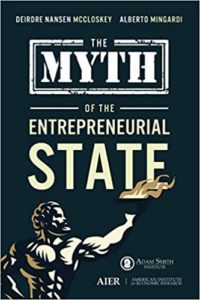Deirdre McCloskey and I recently published a book on The Myth of the Entrepreneurial State for AIER and the Adam Smith Institute (if you buy it, please review it on Amazon). On the AIER website, we have a short piece summarizing one of the book’s arguments.

A few friends asked us the reason why we spent so much time dealing with Mariana Mazzucato and other authors who are retrying to rejuvenate the fallacious ideas of “industrial policy”. Here’s our answer:
In a 1974 interview with Reason magazine, Milton Friedman noted that, “It’s fortunate that the capitalist society is more productive, because if it were not it would never be tolerated. The bias against it is so great that, as it is, it’s got to have a five-to-one advantage in order to survive.” (We would say more like thirty-to-one, the gain since the 18th century from the coming of liberalism.) It is why Mazzucato’s argument is so persuasive to so many. People in a primitive way distrust the price system, and distrust the impersonality of exchange among strangers. Better a sweet family of, say, 330 million people guided by a visible hand of government as a pater familias, advised in its coercions by Professor Mazzucato. If you can persuade people that the market economy does not innovate—no five or thirty to one—they will be happy to renounce it, as people have frequently since socialism was first imagined.
As a little evidence of the traction, these ideas are gaining. Consider this paragraph:
It is often said that every crisis is an opportunity for change and transformation. What we are experiencing is now the third crisis in the space of the last 15 years and this time Italy, Europe and the West have the opportunity to make a real breakthrough that, on the contrary, has been missing after previous episodes of crisis.
Europe has been able to take up this challenge in particular through the Next Generation EU program, through various other initiatives, to which Italy has made a decisive contribution and for which a new pact between public and private, as well as a new strategy for the organization of public presence in the economy, is needed…
This is the Italian prime minister talking to Parliament on November 2nd. Prime Minister Conte is advised by Mariana Mazzucato, who expressed the same views a number of times (see, for example, this blogpost of mine). Consider also Klaus Schwab’s “great reset” (I’ll write more on it in a later post). This rhetoric is very appealing for politicians and is a form of storytelling they envoy, as it boosts their role and importance. For this reason, we tried to contribute to dispel the “myth of the industrial state”.


READER COMMENTS
Cyril Morong
Nov 7 2020 at 3:39pm
Here is an example of how we don’t need industrial policy. A guy in the late 1970s created a working online computer bulletin board system that people all over the world used with very little in the way of capital.
https://www.nytimes.com/2019/12/20/technology/randy-suess-dead.html
“Randy Suess, a computer hobbyist who helped build the first online bulletin board, anticipating the rise of the internet, messaging apps and social media, died on Dec. 10 in Chicago. He was 74.”
“In late January 1978, Mr. Suess (rhymes with “loose”) was part of an early home computer club called the Chicago Area Computer Hobbyists’ Exchange, or CACHE. He and another club member, an IBM engineer named Ward Christensen, had been discussing an idea for a new kind of computer messaging system, but hadn’t had the time to explore it. Then a blizzard hit the Great Lakes region, covering Chicago in more than 40 inches of snow.
As the city shut down, Mr. Christensen phoned Mr. Suess to say that they finally had enough time to build their new system. Mr. Christensen suggested that they get help from the other members of the club, but, as he recalled in an interview, Mr. Suess told him that that would be a mistake because others would just slow the project down.
“Forget the club, it would just be management by committee,” Mr. Christensen recalled him saying, noting that Mr. Seuss had been a self-taught computer technician whose decisions typically came hard and fast. “It’s just me and you. I will do the hardware, and you will do the software.”
The idea was to build a central computer that club members could connect to using their own computers and telephone lines. They thought of it as an electronic version of the cork bulletin boards on the walls of grocery stores, where anyone could post paper fliers.
Two weeks later, their system was up and running, and the club was trading messages about meetings, new ideas and new projects.”
“In the late 1970s and on into the ’80s, as word of their system spread through trade magazines and by word of mouth, hobbyists across the country built their own online bulletin boards, offering everything from real-time chat rooms to video games. These grass-roots services were the forerunners of globe-spanning social media services like Twitter, Facebook and YouTube.
“Everything we do in terms of communicating with other people online can be traced back to Randy and his bulletin board,” said Jason Scott, a computer history archivist who made an online documentary about the creation of C.B.B.S. “The only difference is that now it is all a little slicker.””
Mr. Suess and Mr. Christiansen built their electronic bulletin board using a personal computer called the S-100. After adding a modem that could send and receive data across a phone line, Mr. Suess soldered together some additional hardware that could automatically restart the machine and then load Mr. Christiansen’s software whenever someone dialed in.
“Randy pretty much built it from scratch,” Mr. Christiansen said. “It looked like it was put together with bailing wire and chewing gum.”
Mr. Christiansen offered to run the system from his home in Dolton, Ill., south of Chicago. But Mr. Suess, who lived in the Wrigleyville section of the city, insisted that it stay in his basement, so that anyone in the city could dial in without paying long-distance charges. By the time they retired the system in the 1980s, its single phone line had received more than a half million calls.
Mr. Suess had by then built a much larger system called Chinet — short for Chicago Network — which connected to the internet through a satellite radio. The internet was so small that he could download the whole thing onto his machine in a single evening. Others could then browse this global collection of data, including a new version of C.B.B.S., through 22 phone lines plugged into a bank of modems on a wall.
Some people dialed in from as far away as Australia and Singapore.”
nobody.really
Nov 9 2020 at 9:25am
“Well, the success of the United States in medical research is really incredible. I mean, it’s phenomenal. We spend $30 billion a year of government money, and the private sector goes out and comes up with new drugs. It’s an industry that the U.S. is by far the leader in—creating wonderful jobs, great miracle cures—and that is working super, super well, but we spend more than all other countries put together. And the U.S. lead in health technologies, including drugs, is gigantic, just like the U.S. lead in digital technologies is gigantic.
[T]he original Internet comes from the government, the original chip-foundry stuff comes from the government—and even today there’s some government money taking on some of the more advanced things and making sure the universities have the knowledge base that maintains that lead. So I’d say the overall record for the United States on government R&D is very, very good.
* * *
How well does the Department of Energy spend its R&D budget? And I was worried: Gosh, if I’m going to be saying it should double its budget, if it turns out it’s not very well spent, how am I going to feel about that? But as I’ve really dug into it, the DARPA money is very well spent, and the basic-science money is very well spent. The government has these “Centers of Excellence.” They should have twice as many of those things, and those things should get about four times as much money as they do.
Yes, the government will be some-what inept—but the private sector is in general inept. How many companies do venture capitalists invest in that go poorly? By far most of them.
* * *
Everyone likes to argue about how much the shale-gas boom was driven by the private sector versus government; there was some of both. Nuclear: huge amount of government. Hydropower: mind-blowingly government—because permitting those things, those big reservoirs and everything, you can’t be a private-sector guy betting that you’re going to get permitted. People think energy is more of a private-sector thing than it is…. Since World War II, U.S.-government R&D has defined the state of the art in almost every area.”
Bill Gates
Comments are closed.